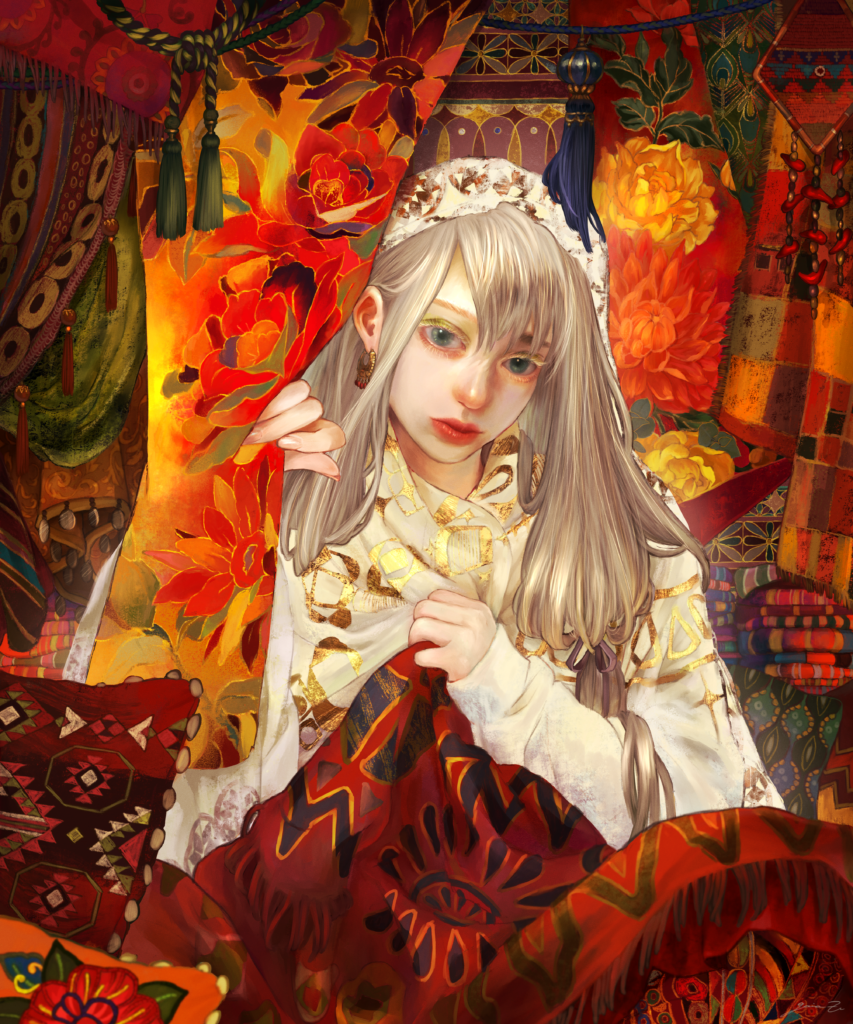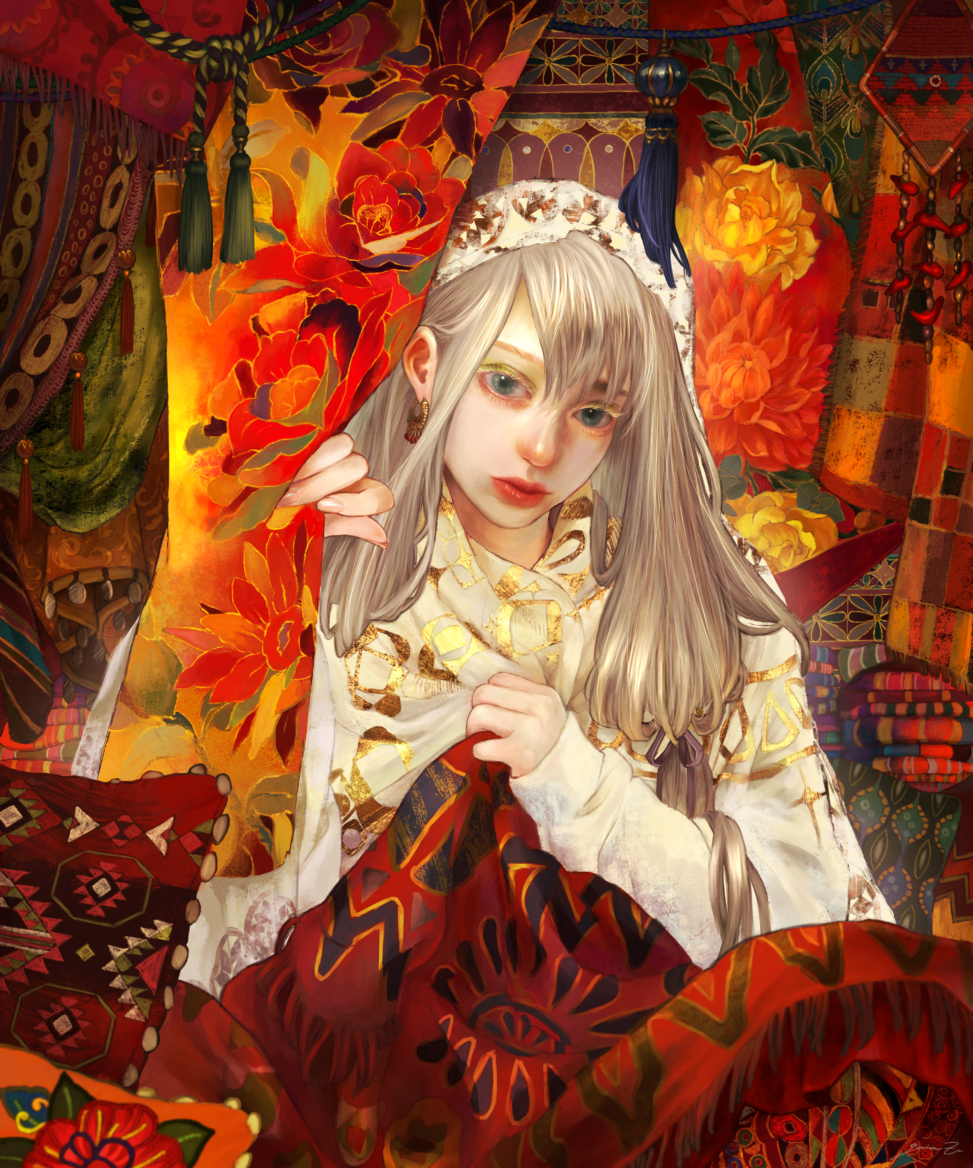
description
ある日、悪魔が現れ村からひとりの青年をさらった。
その青年の婚約者が、彼を返すように悪魔に懇願すると、
「100枚の布に刺繍をたっぷり施せば、青年を返してやる」と言い残して去って行った。
婚約者は何年もかけて丁寧に布地いっぱいに刺繍を施した。
美しい刺繍で埋め尽くされた100枚の布を見た悪魔は、満足そうにそれと引き換えに青年を婚約者へと返した。
それ以来、その村では魔除けとして刺繍を施した衣服を身につけるようになった。
One day, a devil appeared and kidnapped a young man from the village.
His fiancée pleaded with the devil to return him. Then,
The devil left after saying, “Give me 100 pieces of cloth with plenty of embroidery and I will return the him”
She spent years carefully and meticulously embroidering the fabric.
The devil seemed satisfied when he saw 100 pieces of cloth filled with beautiful embroidery. And in exchange for the cloth, the devil returned him to her.
From then on, that village began to wear embroidered garments to ward off evil.
あとがき
どの国においても刺繍というのは独自の文化として受け継いできており、美しい刺繍からはその民族の歴史も垣間見えます。
今回の作品において特にどこの国のというものはなくて、
中央アジアやヨーロッパ、日本など多岐に渡って参考にしています。
古来、刺繍の施された布は、嫁入り道具として持参するものだったり、地位の象徴とされたり、貨幣と同等に扱われたりとさまざまで、
社会的な役割としてはもちろんですが、どの国でも特に共通して多かったのが「魔除け」としての役割です。
日本でも、子供の着物には悪いものが寄ってくると考えられ、背中に「背守り」と呼ばれる刺繍を施す風習があります。同じく中央アジア圏でも、子供の着衣には特に刺繍が多く施され、子供を守ると信じられていたようです。
今回のdescriptionに記した物語は、ハンガリーのマチョーのバラの伝説からインスパイアされています。
実際は、「美しいバラをエプロンいっぱいに持ってくれば青年を返す」と言った悪魔ですが、その時の季節は冬で、バラが一本も咲いていなかったため
代わりに女性はエプロンいっぱいにバラの刺繍を施して渡したのです。
それからマチョー地方では指輪の代わりに魔除けのエプロンを贈る風習も生まれたとか。面白いですね。
一面にびっしりと目の詰まった刺繍は膨大な手間と時間をかけて、布地を少しでも補強する役割もあったかもしれません。
ひと針ひと針手間をかけて紡いだ刺繍たちは、祈りに近く、呪術的でもあり、生物の中でも人間独自のもので、その途方もない労力と想いと美しさがわたしたちを強烈に惹きつけます。
以上のことから実は魔を除けるのではなく、身代わりとしての役目を強く果たしているのではないかと感じています。
この物語に出てくる悪魔は、人が時間と手間、そして祈りや呪いを込めたものに魅了され、執着しているのです。
白は「始まり」を意味する色です。
この白い装束を着てこちらを覗いている人物こそが刺繍に魅せられたその悪魔なのです。
after word
Every country has its own unique culture of embroidery, and the history of the people can be glimpsed through their beautiful embroidery.
In this work, I am not referring to a specific country,
I have used a wide range of references from Central Asia, Europe, and Japan.
Embroidered cloths were variously brought as a bride’s gift, a symbol of status, or treated as equivalent to money.
In addition to its social role, the most common role in all countries was as an amulet.
In Japan, there is a custom of embroidery called “背守りSemamori” on the back of a child’s kimono, as it is believed that children’s kimonos attract bad things.
Similarly, in Central Asia, children’s kimonos were often embroidered and believed to protect children.
The story in this DESCRIPTION is inspired by the Hungarian “legend of the Rose of Machó”.
In the actual story, the devil said, “Bring me a beautiful rose, and I will give you back the him” but the season was winter and not a single rose was blooming at that time.
Instead, the she gave devil an apron with many roses embroidered on it.
Since then, in the Macho region, the custom of giving an apron as a gift to ward off evil instead of a ring has also developed. Interesting.
The embroidery that was applied all over the surface took an enormous amount of time and effort, and may have also served to reinforce the fabric as much as possible.
The embroidery, which is spun stitch by stitch and with all one’s heart, is spellbinding, uniquely human, and intensely fascinating.
In fact, I feel that it may have a strong role as a substitute, not as an amulet.
The devil in this story are obsessed with things that people have put time and effort and prayers and curses into.
Depending on the country, white is the color that signifies “the beginning.
The person wearing this white costume and peering at us is the devil.

